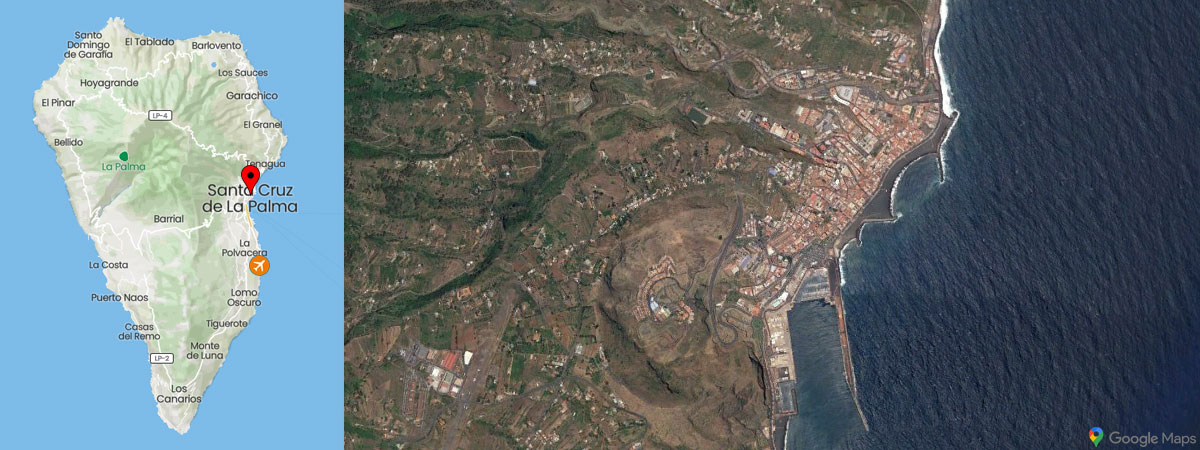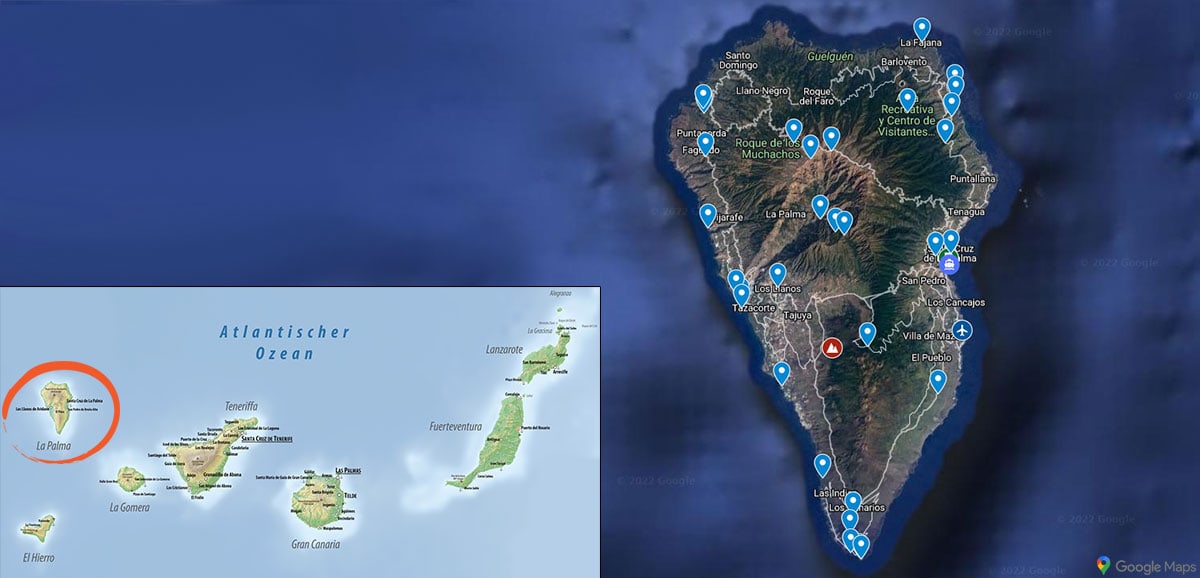The capital Santa Cruz de La Palma on the Canary Island of La Palma shines with cobblestone streets, a Renaissance town hall, some old Canarian and colonial style houses with ornate wooden balconies, a long city beach, and an international cruise port. The best way to explore Santa Cruz de La Palma is to walk through the city on your own.

Table of contents
Things to know about Santa Cruz de La Palma
Santa Cruz de La Palma is the picturesque capital of the island of the same name La Palma, where about 16,000 inhabitants live. It is located on the eastern side of the island and is bordered by forested mountain slopes on one side and the Atlantic Ocean on the other. The city was founded in 1493 and reached its heyday in the 16th century – due to the important trade routes to Europe and America – as the third largest port in Europe after Antwerp and Seville. Because, thanks to its geographical location, almost every ship that traveled between the Spanish mainland and the Americas made a stopover in the Canary Islands and especially in La Palma.
With its colonial, historic city center, Santa Cruz de La Palma is today one of the most important art-historical monuments in the world and attracts tourists from all over the world. You can explore the city on your own in about 2 hours. We especially liked the many cobblestone streets and Canarian architecture.
Santa Cruz de La Palma – Sights & Photo Spots
From our Hotel H10 Taburiente Playa we reached the city of Santa Cruz de La Palma in just a few minutes with our rental car. We parked our car in a parking lot directly at the harbor, which is free for tourists, offers enough parking spaces and from which it takes only about 5 minutes to walk to the old town. The exact location of the parking lot is shown here in Google Maps.
The shopping street Calle O’Daly
Between Plaza de España and Plazuela del Muelle runs the main shopping street of Santa Cruz de La Palma, Calle O’Daly, where you can find many stores, boutiques, cafes and restaurants. Normally the pedestrian zone is well frequented, especially on days when cruise ships dock in the city. However, we walked through the alleys on Easter Sunday, so there was yawning emptiness here. No store was open on the main shopping street (except for a pharmacy) and there was hardly a walker to be seen. Perfect for photos 🙂
Plaza de España – City Hall & Church
The shopping street opens into the Plaza de España, in the center of which is a bronze statue of a priest, erected in 1895. The square, together with the 16th century Renaissance town hall opposite, forms the heart of the old town, which has been declared an art-historical monument. From the Plaza de España, a few steps lead up to the entrance of the main church of El Salvador, built at the beginning of the 16th century in three naves. Particularly striking is the dark-colored church tower, for the construction of which ashlars of volcanic origin were used.
Balcones de la Avenida Marítima
The most important and at the same time most famous sight of the city are the Balcones de la Avenida Marítima, a very well preserved ensemble of houses with typical Canarian colorful wooden balconies from the 19th century. The row of houses is located directly on the promenade of the harbor road Avenida Marítima and is a really nice photo motif.
Real Castillo de Santa Catalina
The fortress Castillo de Santa Catalina was built in 1692 by the Italian master builder Leonardo Torriani from black lava stone and used for military purposes until 1808. Since 1951, the fortress has been a national historical monument and is open to the public.
Plaza de la Alameda
The Plaza de la Alameda is a very beautiful, spacious square located at the northern end of the old town. The many palm trees, the fountain, the benches and the café in the center invite you to linger. Particularly impressive is the large wooden ship ‘Barco de la Virgen’ at the end of the square, which houses the Museo Naval maritime museum. The ship is a replica of the Santa Maria, with which Columbus sailed across the Atlantic. We also found very interesting the small statue ‘Monumento a El Enano’ on the Plaza de la Alameda, which is supposed to remind of the tradition of dancing dwarfs with Napoleon hats on the island.
The beach in Santa Cruz de La Palma
You may find it hard to believe, but the really beautiful and wide sandy beach in the capital Santa Cruz de La Palma has only existed since 2017. It is an artificial beach of fine black sand, characteristic of the volcanic islands, replacing the historic pebble beach Caleta del Varadero. The beach, which is over 1 kilometer long and 50 meters wide, was inaugurated in April 2017, six years after work began. As a result, Santa Cruz de La Palma has now regained direct contact with the Atlantic Ocean, which had been lost since 1949 with the construction of today’s Avenida Marítima.
More sights & photo spots in the old town
During our walk through the alleys of Santa Cruz de La Palma we discovered many more sights and photo spots.
This includes especially many colorful houses, statues, fountains and the old market hall. During our stay on La Palma we walked 2 times through the small streets in the capital, which we really liked 🙂
Maroparque Isla de La Palma Zoo
Maroparque Isla de La Palma is a small zoobotanical park located in the municipality of Breña Alta, just minutes from Santa Cruz de La Palma.
The small zoo is dedicated to the preservation of a variety of exotic animals, many of which are threatened with extinction. A circular trail leads down the slope of El Galeón Gorge over wooden bridges and paved paths. Animals include marmosets, crocodiles, porcupines, meerkats, fish, snakes, coatis, birds of prey, ostriches, monkeys and many more. The special feature is the large walk-in aviaries where you have direct contact with cranes, peacocks, parrots, guinea fowl and ibises. At the entrance we bought a small food packet for 2 euros, the contents of which we fed to some animals during our walk through the zoo. This was definitely fun for young & old 😉
A map with all the sights on the island of La Palma
On the following map at Google MyMaps we have marked all known sights and photo spots. If there is an important point missing, feel free to send us a message on Instagram or by mail and we will be happy to add it.


